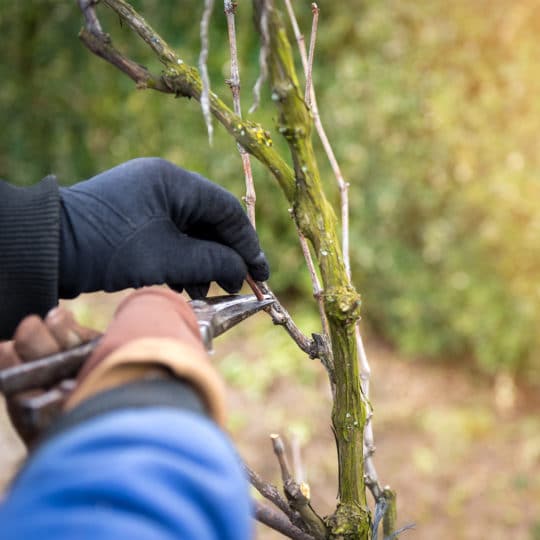Pruning Trees and Shrubs
The Right Way and the Destructive Way
Posted
February 7, 2019

Properly pruning trees and shrubs promotes plant health, encourages new growth, and maintains the right shape so the plant looks healthy as well. Besides the type of tree and time of year, knowing what to do—and what not to do—is all part of the pruning process.
Pruning Around Growth Buds
One of the main things to watch out for while pruning trees and shrubs are new growth buds. You’ll want to select the bud you want to keep and cut just beyond it. This affects how new growth will shape your plant, so it’s important you recognize the three different kinds of buds and how to prune them properly.
- Terminal Buds. Found at the tip of a shoot and leads to a longer branch. These buds restrict the growth of other buds on that shoot.
- Lateral Buds. Found along the sides of a shoot. Sideways growth makes a plant look bushier. These buds stay dormant until the terminal bud is pruned off. When lateral buds are pruned, energy is redirected toward the terminal bud and the branch is likely to grow upward.
- Latent Buds. These are dormant beneath the bark until a branch breaks or is cut just above it, then a new shoot grows to replace what’s been removed.
Tools for Pruning Trees and Shrubs
Having the right tools will help ensure the cut is clean and doesn’t tear the branch bark, which could leave the plant open to pests and disease. Make sure the following tools are clean and sharpened before and after use.
- Hand Shears: Best for branches up to 1⁄4 inch in diameter. It’s easier to make close cuts with these easy-to-use scissor-type shears. Before choosing the right shears, hold them to make sure they fit comfortably in your hand.
- Lopping Shears: For branches up to 1.5 inches in diameter, reach for lightweight lopping shears. Models with extendable handles help you reach higher branches.
- Pruning Saws: The coarse teeth easily prune branches more than 1.5 inches in diameter.
- Pole Pruners: With shears or a saw as its head and a rope mechanism, pole pruners are best used for branches more than one inch thick and beyond arm’s reach. Some models feature a handle that disassembles for storage.
- Hedge Shears: Best for shaping and snipping new growth on shrubs.
Cuts for Pruning Trees and Shrubs
Now that you know what to look for and what tools to use, you’re ready to start pruning. The kind of cut you make will affect the way the tree or shrubs continues to grow. That saying “measure twice, cut once” can be applied to pruning in the way that you choose what branches to cut and measure the angle at which they are pruned before you touch tools to wood.
There are four basic pruning cuts, each producing a different effect. When cutting above a growth bud, angle it at about 45 degrees, with the lowest point of the cut opposite and even to the bud; the highest point about 1/4 inch above the bud.
- Pinching. The only tools required are your thumb and forefinger as you pinch off a terminal bud. This is typically done on flowers and some vegetables, and to direct growth of small-leaved shrubs in order to give the plant an even shape.
- Heading. When you cut farther back on the shoot than you would for pinching. For instance, the lateral bud has already grown a leaf, so you cut right above the leaf with hand-held pruners. This stimulates the buds just below the cut, encouraging dense growth.
- Shearing. Used to create a hedge or a bush with spherical or square form. This is a type of heading that cuts right through the leaves and stimulates many buds to produce new growth. It requires regular maintenance after you start, and it’s best if you use hand-held or electric hedge shears.
- Thinning. Reduce the bulk of a plant with minimal regrowth by removing an entire stem or branch. Use hand-held pruners, loppers, or a pruning saw to make thinning cuts, depending on the thickness of the branch being cut.
Professional Pruning of Trees and Shrubs
If all of this seems a little overwhelming, it’s a good idea to have someone experienced with proper pruning show you what’s best for the types of plants in your yard. Contact Cardinal Lawns for more information and a pruning consultation.

Download Your FREE Summer Plant Care Guide
Help your plants make it through a hot & dry summer looking like a million bucks with our summer plant watering and maintenance guide!